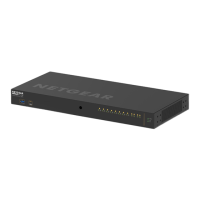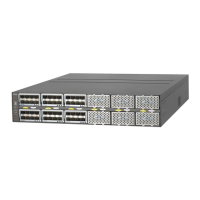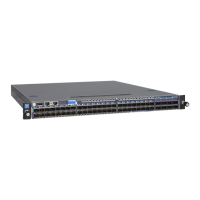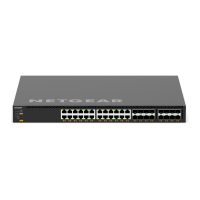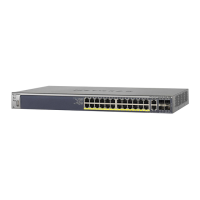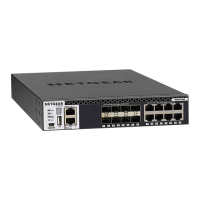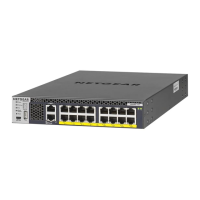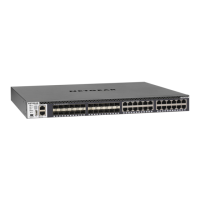
Do you have a question about the NETGEAR M4200 and is the answer not in the manual?
| Model | M4200 |
|---|---|
| Type | Managed Switch |
| Rack Mountable | Yes |
| Management | Web-based GUI, CLI, SNMP |
| Ports | Varies by model (24 or 48 ports) |
| Layer | Layer 2/3 |
| Power over Ethernet (PoE) | Available on some models (PoE+) |
| Switching Capacity | Varies by model (up to 176 Gbps) |
| Forwarding Rate | Varies by model (up to 131 Mpps) |
| Form Factor | 1U |
| Operating Temperature | 0 to 40 °C |
| Storage Temperature | -20° to 70° C (-4° to 158° F) |
| Humidity | 10% to 90% (non-condensing) |
Shows how to assign ports to VLAN2 and configure tagged/untagged frame transmission.
Provides CLI and web interface procedures to create three VLANs and assign VLAN IDs.
Shows how to assign ports to VLAN 3 and configure frame acceptance.
Explains classifying traffic based on source MAC address for VLAN assignment.
Details creating protocol VLAN groups based on IPX and IP/ARP protocols.
Describes assigning workstations in an IP subnet to the same VLAN without reconfiguring network addresses.
Explains separating a VLAN domain into subdomains (primary, secondary) for Layer 2 isolation.
Provides steps to assign VLANs as primary, isolated, or community types.
Shows how to associate secondary VLANs to a primary VLAN for private VLAN configuration.
Details assigning ports to promiscuous or host port modes for private VLANs.
Explains associating isolated and community ports to private VLANs.
Provides CLI and web interface procedures to add ports to Link Aggregation Groups (LAGs).
Details enabling Layer 2 bridging and Layer 3 routing, including IP forwarding and ARP mapping.
Details enabling routing for specific ports and configuring IP addresses and subnet masks.
Provides an example of configuring a switch to support VLAN routing with egress frame tagging enabled.
Details configuring IP addresses and subnet masks for virtual router ports to enable VLAN routing.
Provides CLI and web interface procedures to enable RIP globally on the switch.
Details enabling routing for specific ports and assigning IP addresses and subnet masks.
Shows how to enable RIP for the switch, with default route preference.
Provides CLI and web interface steps to enable RIP for specific ports, including frame formatting.
Adds support for RIPv2 to the base VLAN routing configuration for network connectivity.
Shows how to configure a switch as an inter-area router and border router connecting different OSPF areas.
Provides CLI and web interface procedures to configure OSPF on a border router for network connectivity.
Adds OSPF support to the base VLAN routing configuration for network connectivity.
Demonstrates PBR configuration for load sharing across multiple paths based on packet entities like IP address ranges.
Provides CLI examples for the show ip interface and ip proxy-arp commands to demonstrate proxy ARP functionality.
Provides CLI and web interface steps to configure a switch as a VRRP master router for virtual route redundancy.
Provides CLI and web interface steps to configure a switch as a VRRP backup router for failover scenarios.
Details configuring Layer 2 ACLs to inspect packet fields like Source/Destination MAC address, VLAN ID, and EtherType.
Describes classifying Layer 3 traffic using IP ACLs based on Source/Destination IP address, ports, and protocol.
Demonstrates setting up an IP ACL with two rules (TCP and UDP) to accept packets with specific source/destination IP addresses.
Provides CLI and web interface procedures to set up a MAC ACL with two rules to permit or deny traffic based on MAC addresses.
Covers port egress queue configuration and drop precedence, including scheduler types and queue management.
Provides CLI and web interface steps to set the Class of Service Trust Mode for an interface or globally.
Details setting minimum bandwidth per queue and configuring scheduler types (strict vs. weighted).
Provides an example of how a network administrator can provide equal internet access to different departments with differentiated bandwidth.
Details using DiffServ to support Voice over IP (VoIP) traffic with guaranteed transmission rates and priority.
Provides CLI and web interface examples for enabling IGMP snooping on VLANs for better multicast traffic handling.
Provides CLI and web interface steps to enable the IGMP querier feature for managing multicast groups.
Details configuring MVR in compatible mode where the switch does not learn multicast groups, requiring static configuration.
Explains configuring MVR in dynamic mode where the switch learns multicast groups by snooping IGMP queries and forwarding reports.
Provides CLI and web interface steps to set dynamic and static MAC address limits on a specific port.
Describes setting up protected ports to prevent traffic forwarding between ports within the same Layer 2 segment.
Explains configuring 802.1x port security to prevent unauthorized clients from connecting to a VLAN via authentication.
Shows how to create a guest VLAN for providing distinguished service to dot1x-unaware clients, allowing limited network access.
Explains how RADIUS server can assign clients to appropriate VLANs for flexible network access without static VLAN configuration.
Details DAI as a security feature that rejects invalid ARP packets by validating MAC/IP addresses against DHCP snooping bindings.
Explains DHCP snooping as a security feature to filter DHCP messages and build a bindings database of authorized clients.
Describes how to identify a rogue DHCP server by checking DHCP snooping statistics and logs.
Details IP Source Guard using DHCP snooping bindings to drop packets not matching bindings, enforcing source IP or MAC address.
Provides CLI and web interface steps to configure MAB using a Microsoft Network Policy Server.
Details configuring SNTP server IP addresses and enabling client mode for time synchronization.
Explains how switches automatically identify and mitigate network loops by disabling ports or sending log messages.
Provides CLI and web interface commands to display general logging status, received, dropped, relayed, and ignored messages.
Provides CLI and web interface steps to configure logging settings for a specific port, including host and severity filters.
Provides instructions for installing switches in a rack, connecting stacking cables, and powering up the stack.
Details procedures for adding new switches, removing existing ones, or replacing stack members in an operating stack.
Provides CLI and web interface steps to add a new SNMP community string for network management access.
Details enabling SNMP traps to send notifications to an SNMP server for events like link status changes.
Provides CLI and web interface steps to specify two DNS servers for IP address resolution.
Provides CLI and web interface steps to create a DHCP server with a dynamic IP address pool.
Details setting up a DHCP server to assign a fixed IP address based on a client's MAC address.
Provides CLI steps to create a DHCPv6 pool and enable DHCP service for prefix delegation.
